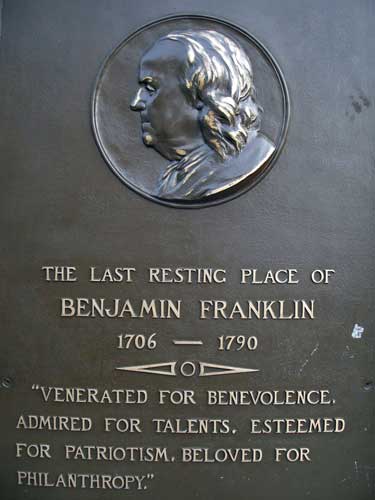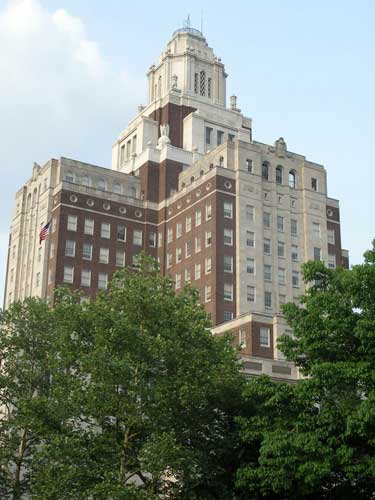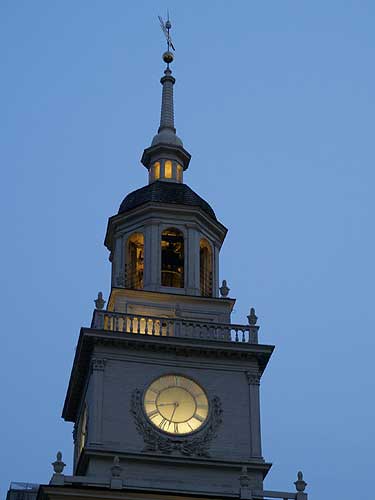Elfreth's Alley, built in 1702, is the nation's oldest continuously inhabited residential street. Named after blacksmith Jeremiah Elfreth, the current houses date from 1728 - 1836.





This small alleyway, known as Bladen's Court, was built between 1749 - 1752. It was paid for by two neighboring home owners who wanted outside access to their backyards. The owners, William Rush and his brother-in-law Abraham Carlisle, had opposing political beliefs during the American Revolution. Rush allied himself with the patriots whereas Carlisle with the British. Carlisle was hanged for his collaboration in 1778. The alley takes its name from William Bladen, a biscuit maker, who owned the property during the early 1800's.
When Betsy Ross (1752 - 1836) lost her husband in 1776, she supported herself as an upholsterer. According to the story, George Washington, Robert Morris and George Ross (Betsy's late husband's uncle), visited her in 1777 in her shop and asked if she could make a flag from a sketch. Apparently she could and sewed the first stars and stripes on ship flags defending Philadelphia.


The Betsy Ross House

The Christ Church Burial Ground is most famous for the final resting place of Benjamin Franklin.


Benjamin Franklin was an incredible man by anyone's views. He broke all the rules as well as defined them.
- was one of the Founding Fathers, helped draft and signed the Declaration of Independence, was the Pennsylvania delegate at the Second Continental Congress, signed the Constitution
- was the first US Postmaster General, governor of Pennsylvania, and a Justice of the Peace for Philadelphia
- invented the lightning rod, bifocals, the glass harmonica and the Franklin stove, but never patented any of his inventions so that others could freely use them
- founded the American Philosophical Society to help scientists discuss their discoveries and theories
- was a successful publisher and printer, including the first German language newspaper in the US, created the ever popular Poor Richard's Almanack
- served as ambassador to France
- organized the Pennsylvania Militia for the Continental Army
- started the first public library and one of the country's first volunteer firefighting companies
- obtained a charter to establish the first hospital in the US
- was first president of the University of Pennsylvania and created a new style of college that would focus on the professions, be taught in English instead of Latin, have professors who were experts in their subject matter instead of one tutor leading a class for four years, and there would be no religious test for admission
- freed his slaves, advocated opening a school for the education of black slaves in Philadelphia
- got honorary degrees from both Harvard and Yale
- played the violin, harp and guitar, also composed music
- was an avid chess player
- printed currency for New Jersey based on anti-counterfeiting techniques he had devised
- was a Freemason Grand Master, published the first Masonic book in the Americas
- published a chart on the the flow of the Gulf Stream
- published his oceanographic findings with ideas for sea anchors, catamaran hulls, watertight compartments, shipboard lightning rods and a soup bowl designed to stay stable in stormy weather
- set up trusts for Boston and Philadelphia to gather interest for 200 years, which could then be spent to benefit each city
- had a common-law marriage with Deborah Read, a woman was not free to officially marry since her legal husband had run off to Barbados with all her money to escape debt and prosecution
- had an illegitimate son whom he raised


Benjamin (1706 - 1790) and Deborah Read Franklin (c. 1708 - 1774)


A few more town views...

The National Constitution Center serves as a museum, national town hall and hosts public discussions, including presidential debates.

Even though the US capital was moved to Washington DC, the manufacture of coins remained here. Although there are mints in Denver and San Francisco, at least half of the nation’s circulating coins are struck in this building. The first building opened in 1792 about two blocks away. The current building, opened in 1969, is the fourth Philadelphia Mint.

The US Custom House was built from 1932-34 in an Art Deco style. At 17 stories and 287 feet, it towers above the other historic buildings. It currently houses many federal offices.


Beautiful old buildings



The brick bridge over Filbert Street was designed in 1912, conjuring up thoughts of Venice's Bridge of Sighs. It originally connected the two buildings (formerly Lit Brothers Department Stores) for the purpose of moving merchandise.

A Fox Squirrel stops for a bite to eat...

... but not at one of the city's famous Philly Cheesesteak restaurants. The local speciality was developed in the early 1930's by serving chopped steak on an Italian roll. Add onions and cheese and voila!

This way to Chinatown.
As evening began to set, we made our way back out of town.

Goodbye, US Custom House.

Good night, Indendence Hall.

Rest well, Liberty Bell.
return

